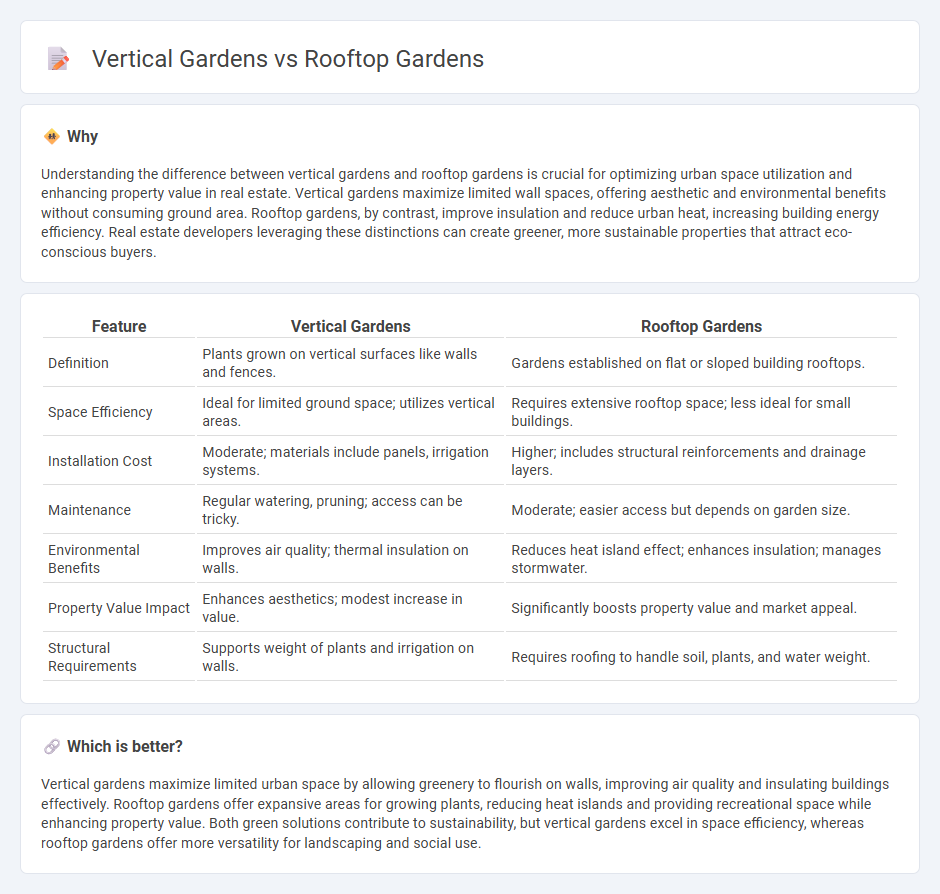
Vertical gardens maximize urban space by using walls to grow plants, enhancing air quality and insulation with minimal ground footprint. Rooftop gardens transform unused roof areas into green spaces, improving building energy efficiency and offering recreational benefits. Explore the advantages and design considerations of vertical and rooftop gardens to optimize your real estate value.
Why it is important
Understanding the difference between vertical gardens and rooftop gardens is crucial for optimizing urban space utilization and enhancing property value in real estate. Vertical gardens maximize limited wall spaces, offering aesthetic and environmental benefits without consuming ground area. Rooftop gardens, by contrast, improve insulation and reduce urban heat, increasing building energy efficiency. Real estate developers leveraging these distinctions can create greener, more sustainable properties that attract eco-conscious buyers.
Comparison Table
| Feature | Vertical Gardens | Rooftop Gardens |
|---|---|---|
| Definition | Plants grown on vertical surfaces like walls and fences. | Gardens established on flat or sloped building rooftops. |
| Space Efficiency | Ideal for limited ground space; utilizes vertical areas. | Requires extensive rooftop space; less ideal for small buildings. |
| Installation Cost | Moderate; materials include panels, irrigation systems. | Higher; includes structural reinforcements and drainage layers. |
| Maintenance | Regular watering, pruning; access can be tricky. | Moderate; easier access but depends on garden size. |
| Environmental Benefits | Improves air quality; thermal insulation on walls. | Reduces heat island effect; enhances insulation; manages stormwater. |
| Property Value Impact | Enhances aesthetics; modest increase in value. | Significantly boosts property value and market appeal. |
| Structural Requirements | Supports weight of plants and irrigation on walls. | Requires roofing to handle soil, plants, and water weight. |
Which is better?
Vertical gardens maximize limited urban space by allowing greenery to flourish on walls, improving air quality and insulating buildings effectively. Rooftop gardens offer expansive areas for growing plants, reducing heat islands and providing recreational space while enhancing property value. Both green solutions contribute to sustainability, but vertical gardens excel in space efficiency, whereas rooftop gardens offer more versatility for landscaping and social use.
Connection
Vertical gardens and rooftop gardens both maximize urban green space by integrating vegetation into built environments, enhancing air quality and reducing urban heat island effects. These sustainable landscaping techniques contribute to energy savings by providing natural insulation and improving building aesthetics, which can increase property values. Incorporating vertical and rooftop gardens supports biodiversity and stormwater management, making them vital components of eco-friendly real estate developments.
Key Terms
Green Roof
Green roofs, also known as rooftop gardens, offer sustainable urban solutions by covering building tops with vegetation to improve insulation, reduce stormwater runoff, and enhance biodiversity. Unlike vertical gardens that maximize wall space for plant growth, green roofs provide extensive habitats and regulate building temperature more effectively. Discover more about how green roofs transform urban landscapes and promote environmental benefits.
Living Wall
Living walls, a type of vertical garden, maximize urban space by allowing plants to grow vertically on structures, enhancing air quality and insulation while requiring minimal ground area. Unlike rooftop gardens that rely on horizontal surfaces, living walls effectively transform blank facades into vibrant ecosystems, offering benefits such as noise reduction and increased biodiversity. Discover more about how living walls can revolutionize green architecture and sustainable urban design.
Urban Sustainability
Rooftop gardens enhance urban sustainability by reducing heat islands, improving air quality, and managing stormwater runoff through vegetative layers on building roofs. Vertical gardens optimize limited urban spaces by integrating plants on building facades, promoting biodiversity and energy efficiency through natural insulation. Discover more about how these green solutions transform city living and contribute to sustainable urban environments.
Source and External Links
Roof Garden - A roof garden provides decorative benefits and can offer food, temperature control, and hydrological advantages, often used for urban agriculture.
Benefits of Rooftop Gardens - Rooftop gardens offer numerous benefits, including improved air quality, reduced urban heat island effects, and effective use of rainwater.
The Evergreen Benefits of Rooftop Gardening - Rooftop gardens can thrive in various environmental conditions, providing a sustainable and visually appealing space for gardening year-round.
 dowidth.com
dowidth.com